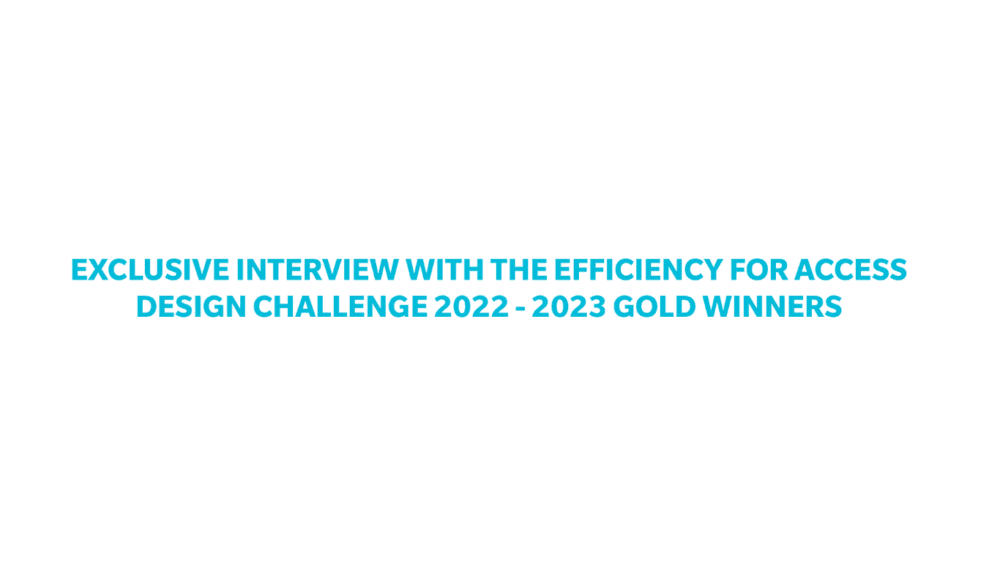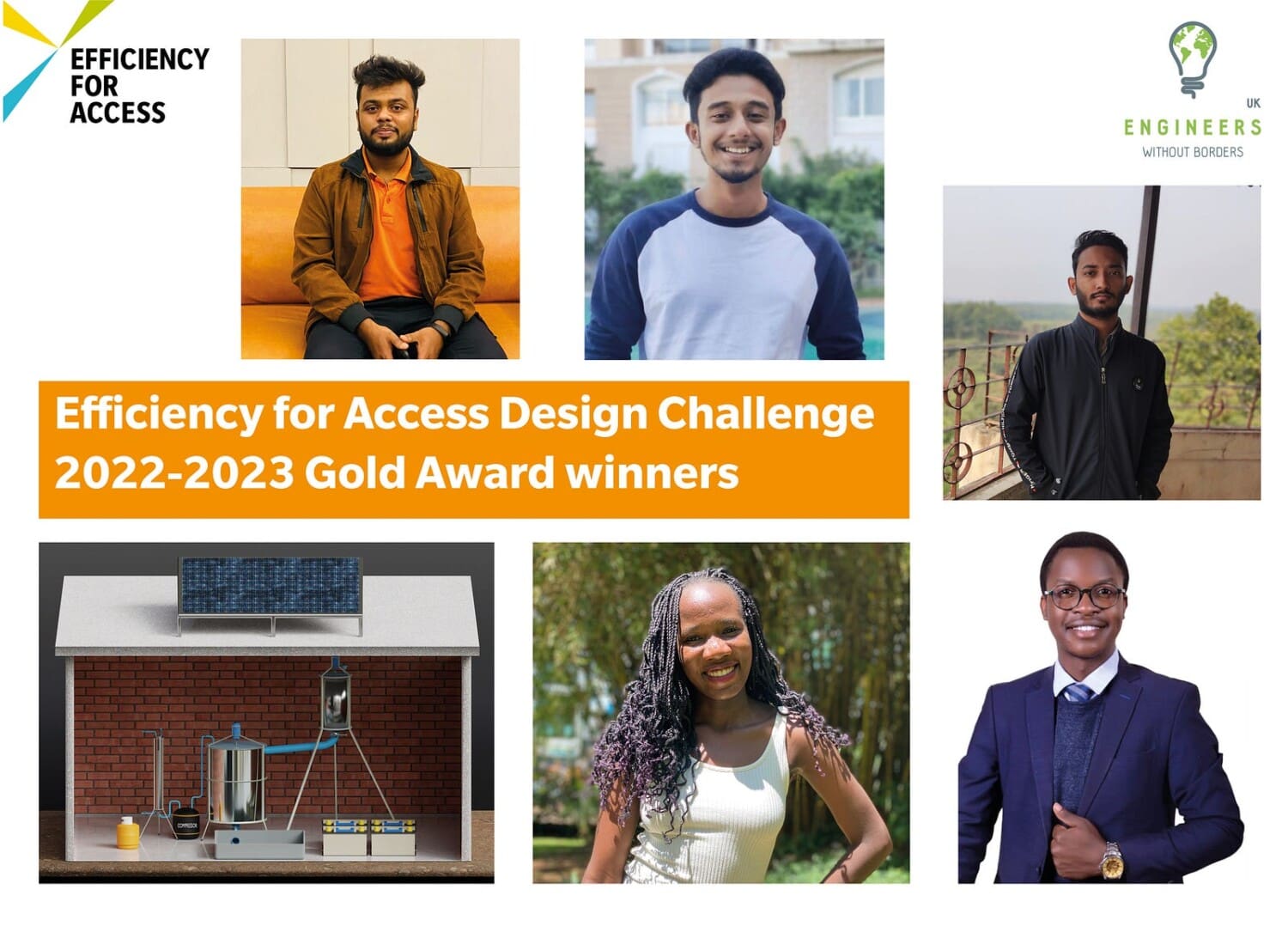Exclusive Interview with the Efficiency for Access Design Challenge 2022 – 2023 Gold Winners
We had the privilege of sitting down with the students behind this environmentally beneficial design.

It has been a couple of weeks since the highly anticipated Efficiency for Access Design Challenge Grand Final took place on 15 June, 2023. The event brought together university students from around the world, to showcase their innovative designs. Among the many talented participants, one team stood out and claimed the coveted gold award. The joint entry from Independent University, Bangladesh and Makerere University based in Uganda, emerged as the inspiring winner with their remarkable design of a solar-powered automated anaerobic digestion system that produces cooking gas and a crop fertiliser from food waste.
We had the privilege of sitting down with the students behind this environmentally beneficial design. The team comprises Siam Ibne Masud and Eazaz Ahamed from the Independent University, Bangladesh, as well as Tarikul Islam Shaikat who unfortunately couldn’t make the call, along with Amviko Proscovia Adrabo and Mutenga Mark Irumba from Makerere University.

In this interview, they shared their insights, experiences, and the story behind their inspiring achievement.
Could you talk to me about your emotions at the time when you found out you had won, but also now, a week on?
Siam: I had so many mixed feelings, my Mom being super proud, my supervisor will be super happy, my family and friends who vouched for us, all ran through my mind.
Proscovia: I honestly expected us to win the People’s Award. I put my whole family on task, “you’re going to tell all your friends.” I was on a motorcycle with my phone at my ear, and heard the announcement, I was so happy. I thought if Siam was in this country right now I’d give him a big hug!
Could you tell me a little bit more about how much work you put into it?
Siam: A lot of work was put into this. We probably joined in meetings for around 70 days, at 3–4 hours each time, so in total we spent about 250 hours on the report!
Mark: This is the longest project I’ve ever worked on, it took a whole year! We had meetings in different time zones with three-hour differences, so Siam was up at three in the morning.
Could you talk about the challenges of collaboration, like juggling time zones? Were there any extra advantages from collaborating with two universities?
Siam: Yes, I may see things right from my perspective, but others spotted problems. You need other people to point out mistakes.
Proscovia: We each brought challenges that each of our countries face, showing different markets in Bangladesh and Uganda.
Mark: It created a lot of diversity, with relatable problems. We could combine our common problems and think broadly about them.
Eazaz: Not only were we from two universities working together, but also Mark and Proscovia are from a different department. We had a problem with the design, like whether to use two motors, or a gear system, and the Ugandan team pointed out the gear system would cost more, or make the design less energy efficient. So we came to the conclusion to use two motors for each chamber.
So the Independent University, Bangladesh won gold for a second time, what was it like to bring the award home again?
Eazaz: Honoured and proud that we won two times in a row!
Mark: For us, when we learnt we were working with Bangladesh who had won before, we were very confident! We trusted them, and saw them as winners to count on!
Siam: I said, this is my last year at Independent University, Bangladesh, the final thing I want to do is get the gold award and bring it home.
Could you shed some light on the initial inspiration? How you got started, and what motivated you?
Siam: In Bangladesh, there is a site where so much waste is piled up, and with emissions coming out that can have an impact on the environment, so our supervisor said “can you reuse those gas emissions to do something?” This was one way to spotlight a project that is fully solar powered, unique and very user friendly, all in one project; mechanical pre-treatments, chemical pre-treatments, and of course purification of biogas. It’s like a 3-in-1 project.
Has being in this competition encouraged you to pursue jobs in the renewable energy sector?
Siam: Absolutely, the problem we tried to fix is just one of many problems around the globe. We tried to reduce cutting trees in rural areas and to reduce the price of cooking gas to make it affordable. Shifting into the green space is the way to go, this challenge motivates students at a young age to pursue projects that make the world better again.
Mark: I was very excited about the idea of off-grid energy. I live in a country where electricity is in the city, and not elsewhere. I thought whether we can as engineers make products that work off-grid, with natural energy. We should have products that are good for everyone in the world, including developing countries.
Do you have advice for future students who are undecided about participating in the challenge?
Siam: My decision to participate was one of the greatest decisions I’ve made. The Efficiency for Access Design Challenge taught me how to design an impactful project that changes the world. The teams you’ll work with in meetings and workshops, and the criteria provided through the Challenge, gives you an idea of how to design a project. I later realised it’s like a step-by-step guide to making sure your project stands up and is good enough to represent in front of the whole world.
Mark: For me, the Efficiency for Access Design Challenge is a summary of our degree and programme, this is when we realise our purpose as engineers, developing products to impact the societies where we live, in our own neighborhoods.
What, if anything, do you think you’ve learnt about yourself through working on this project?
Mark: Proscovia is a Catholic, I’m a seventh day Adventist, Siam and Eazaz are Muslims. They had Ramadan, Proscovia couldn’t be available because of Lent, and we had a meeting on a Saturday that I couldn’t attend as it was Sabbath for me. So we were working with a lot of diversity in time zones, religion, culture, race, but that’s what makes the team work, we appreciate each other and have a lot of respect. Throughout the project Siam respected everyone, kept time, updated all of us, called us to meetings, he is a good leader, I have notes for my leadership skills.
Proscovia: Working with others was a very good experience, we learnt so much especially when it came to having that spirit of not giving up. If you hold back, you are holding back your teammates. I told myself I have the ability to win. I also learnt to have a little more patience to do the best work.
Siam: Conflict management is something I acquired to make sure all teammates understood what was going through my mind. There were times the team had problems, and I would ensure we move on and keep making progress. It’s been a rollercoaster ride! One of the biggest efforts put into the project is the 3D modelling completely done by Eazaz. As for my Ugandan teammates, they know what I went through personally, the amount of love they gave me is something I appreciate to this day.
Our interview with the winners highlights the role of expertise, diversity, and most importantly, friendship during the team’s creation of the winning design. The Efficiency for Access Design Challenge not only strives to nurture these very qualities but also enhance knowledge and skills within the off-grid sector.
Watch the full recording of the Grand Final to see these inspiring gold award recipients, along with other talented participants, as they receive their well-deserved recognition. Take a closer look at their designs on our website.
The Efficiency for Access Coalition is coordinated jointly by CLASP and Energy Saving Trust. LEIA is funded by UK aid, from the UK government via the Transforming Energy Access platform and the IKEA Foundation.
Find out more about the Efficiency for Access Design Challenge.